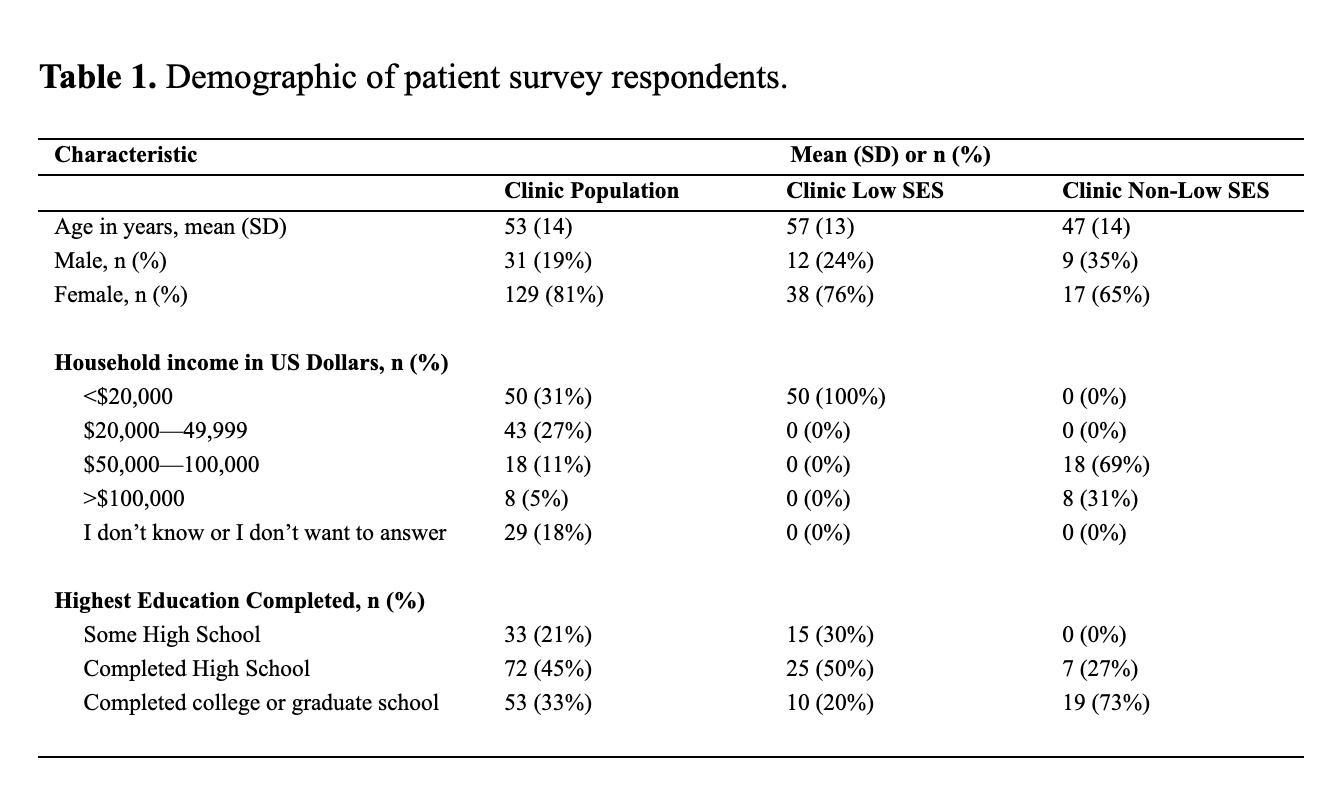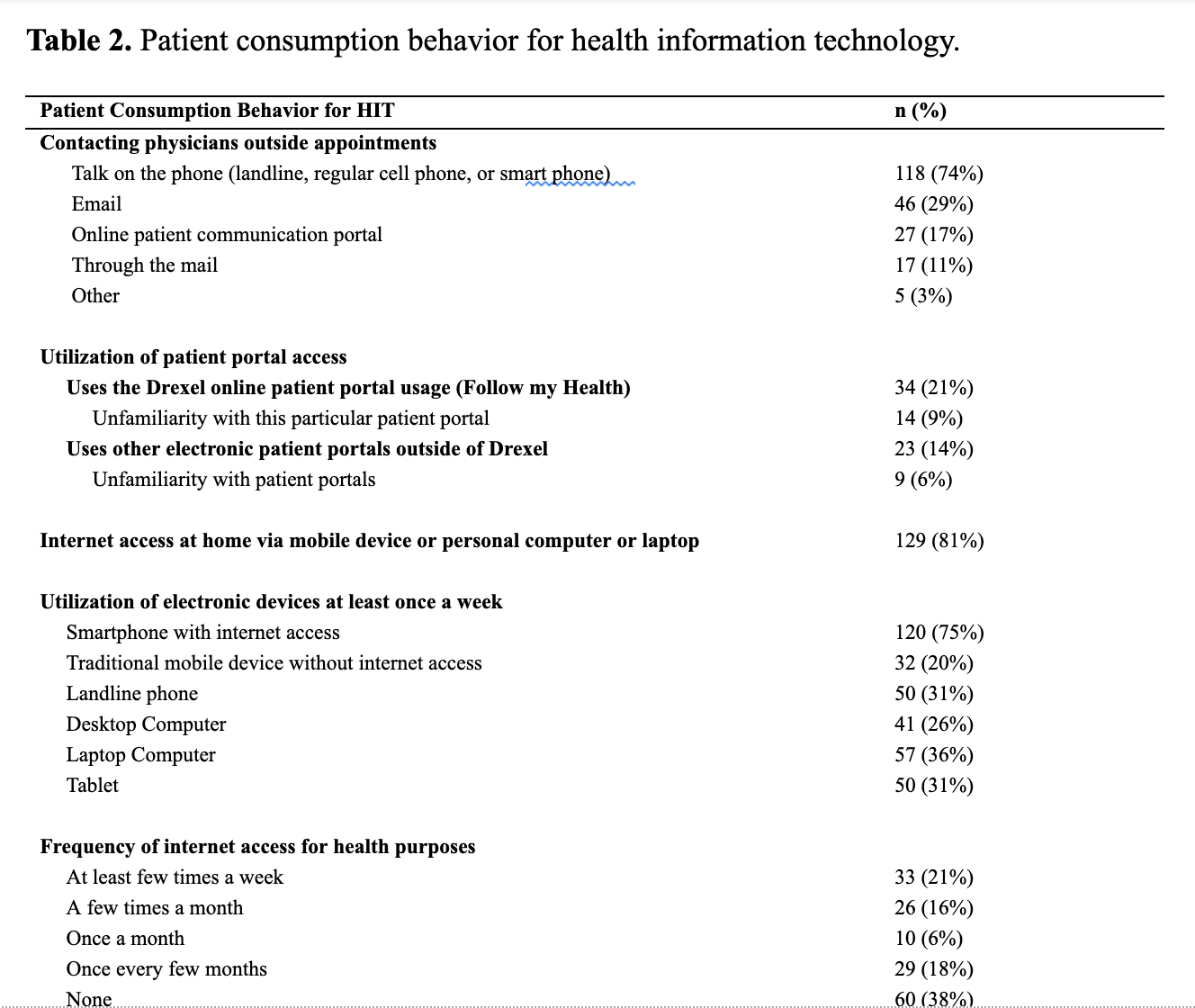Session Information
Date: Sunday, November 8, 2020
Title: Patient Outcomes, Preferences, & Attitudes Poster II: Miscellaneous Rheumatic Diseases
Session Type: Poster Session C
Session Time: 9:00AM-11:00AM
Background/Purpose: Advances in treatment of rheumatologic diseases have increased emphasis on physician and patient use of health information technologies (HIT). While studies indicate that e-health platforms can improve rheumatology outcomes, patients with rheumatologic disease are at risk for being caught on the wrong side of the digital divide. However, despite this potential disconnect, few studies have examined barriers to e-communication and preferences in rheumatology.
Methods: We investigated preferences regarding e-communications in an urban rheumatology clinic using a patient survey to quantify HIT access, identify barriers to HIT access, and evaluate HIT preferences. We used a cross-sectional survey design to study patients from our rheumatology clinic (n=160, 81% female, 19% male, average age 53, SD 14 years).
Results: Demographic characteristics are shown in Table 1. The high percentage of female respondents is in accordance with the institutional analysis of all patients visiting the Drexel Rheumatology Clinic for the duration of the study (82% female and 18% male, average age 54 years old with SD of 14, n=687).
Patients reported their preferred method of contacting physicians as being the phone (74%) followed by email (29%), online patient portal (17%), mail (11%), and other, such as in person (3%) (Table 2). The general population of rheumatology patients does not use patient portals. Specifically, only 21% of survey participants reported using Drexel’s online patient portal, FollowMyHealth, while 14% reported using external electronic patient portals.
A large percentage of patients reported believing that it is very important or absolutely necessary to contact physicians electronically (40%) (Table 3). Respondents reported their main preferred method of internet access as being a mobile device (64%) followed by home computer (44%), tablet (23%), outside computer (8%).
Cross-tabulation analyses indicate that the rate of internet access for an urban rheumatology clinic is similar to that of the general population. Within the clinic, higher SES demographic is significantly associated with higher internet access (χ21, N=76=28.27, P< 0.01), utilization of internet for health purposes (χ21, N=76=7.82, P< 0.01), use of smartphones (χ21, N=76=8.55, P< 0.005) and laptops (χ21, N=76=3.85, P< 0.05) for HIT access, and rating of the importance of contacting physicians electronically (χ21, N=76=4.45, P< 0.05).
Conclusion: Our institutional experience confirms that the rheumatology clinic population faces a digital divide. As expected, individuals of low SES in comparison to higher SES exhibit differences in access to, use of, and perception of HIT. We also note a low adoption rate of e-health platforms, suggesting that despite the development and promotion e-communication, mobile health applications, and tele-health technologies, further effort is required to improve access to and comfort with HIT for rheumatology patients. Physician and patient education, intervention programs, and technology improvements should be explored to narrow this observed digital divide for rheumatology patients, inclusive of and tailored for low SES patient populations.
To cite this abstract in AMA style:
Youm B, Jayatilleke A. Access to Digital Health in an Urban Rheumatology Population [abstract]. Arthritis Rheumatol. 2020; 72 (suppl 10). https://acrabstracts.org/abstract/access-to-digital-health-in-an-urban-rheumatology-population/. Accessed .« Back to ACR Convergence 2020
ACR Meeting Abstracts - https://acrabstracts.org/abstract/access-to-digital-health-in-an-urban-rheumatology-population/



